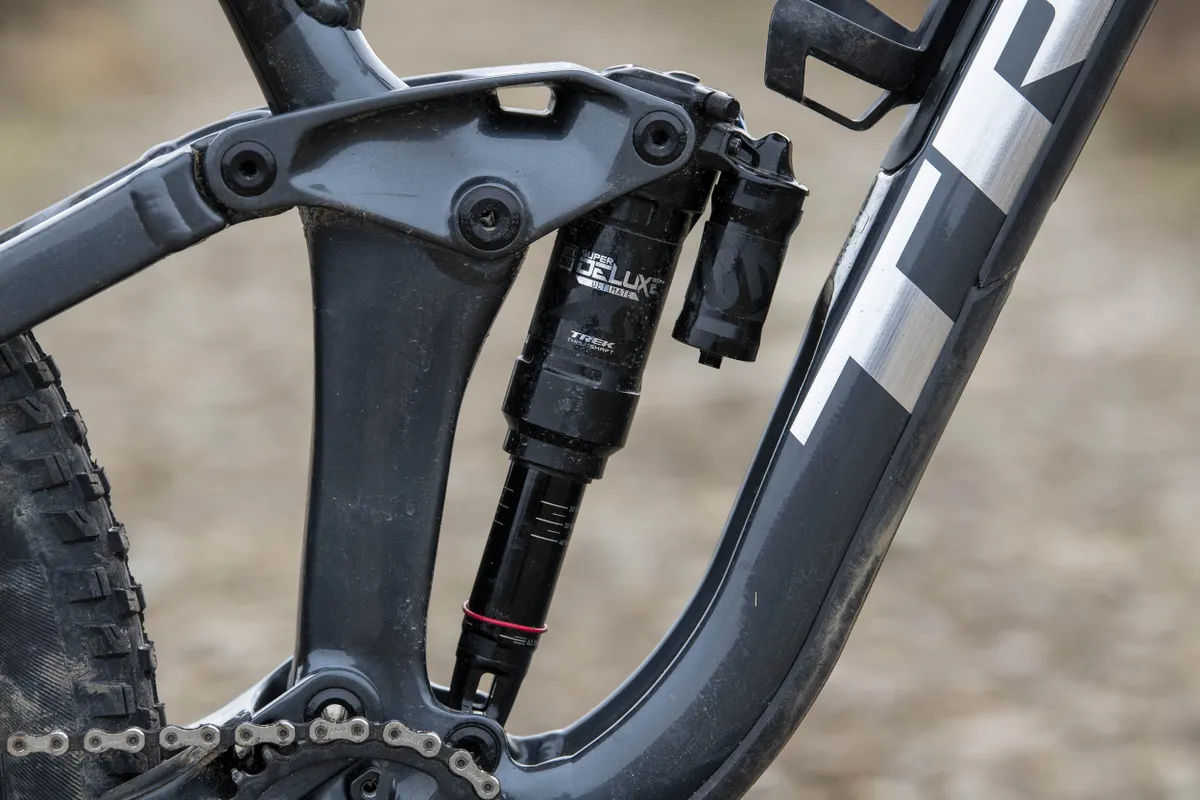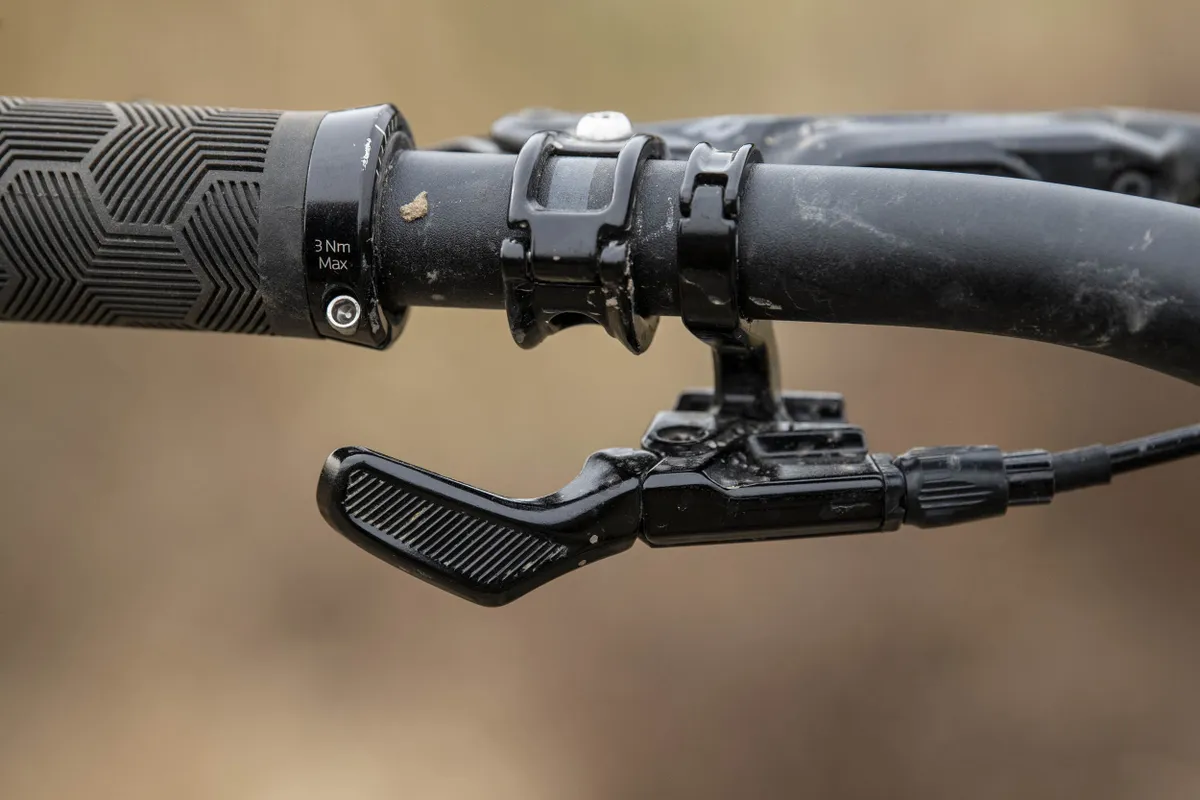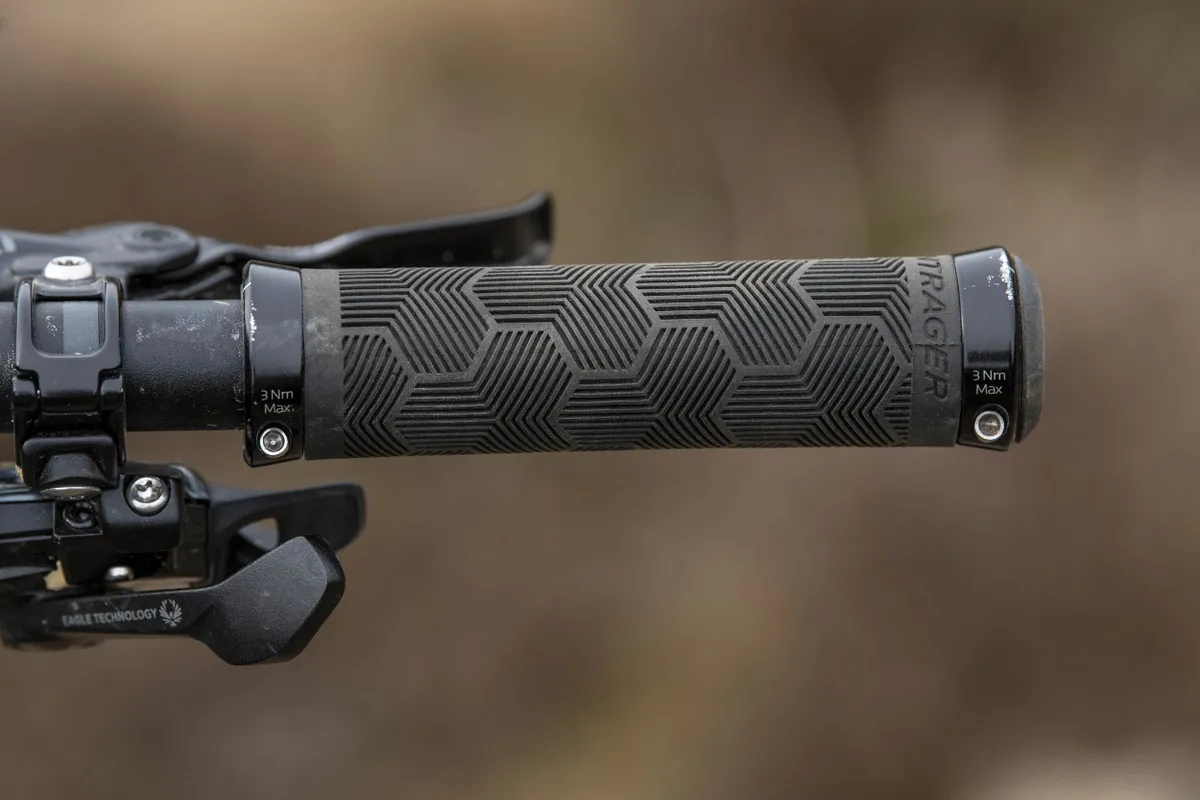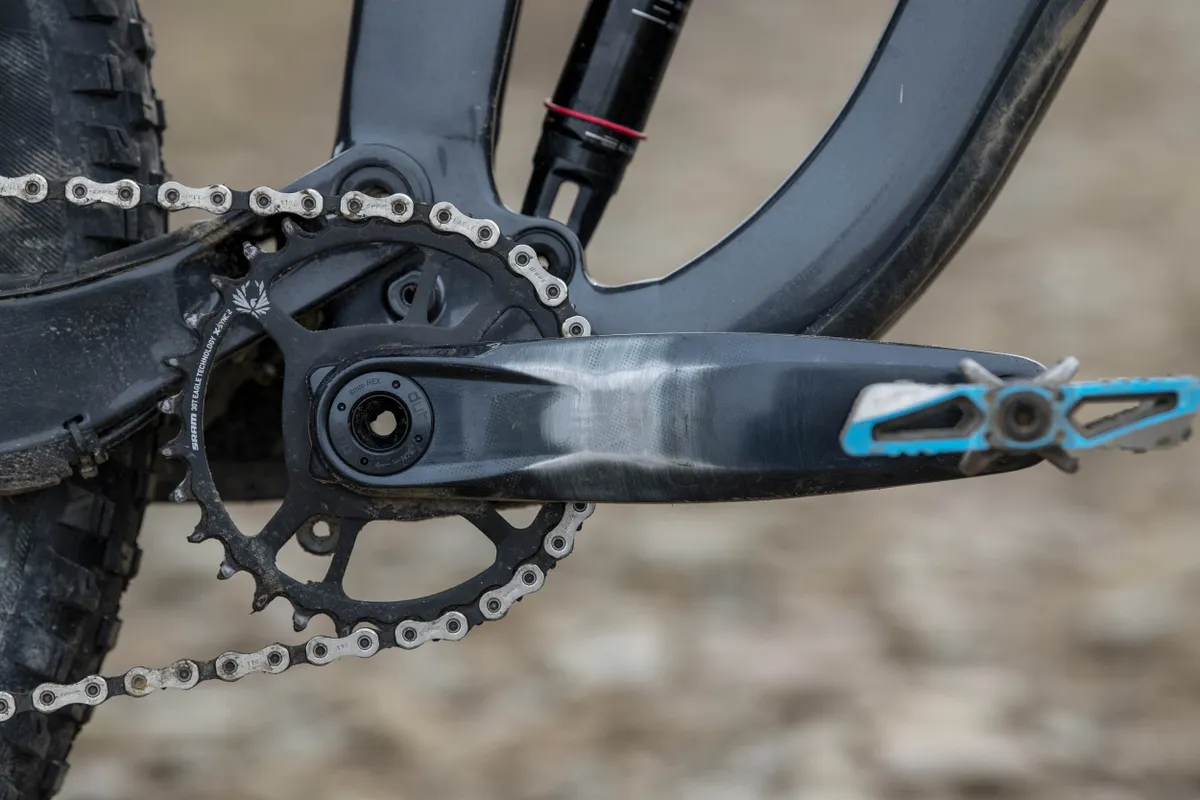The Trek Slash 8 is our Enduro Bike of the Year for 2021. After pitting it against seven of the best out there, all at a similar price, it was the Slash 8 that impressed us most in the end.
Meeting the criteria to win this category is no easy feat and the bikes at the pointy end of this test ticked just about every box going.
For a start, while an enduro bike might be designed to go downhill fast, it still needs to get to the top of the hill as efficiently as possible. It’s then got to handle all manner of trails thrown at it with composure and control, but still remain fun and playful throughout.
It took some serious time and effort back-to-back testing all eight of these bikes, which ranged in price from £3,450 to £4,198, riding them on a wide variety of trails and pummelling them relentlessly over rock and root until we found a winner.
Once the dust had settled, it was the Trek Slash 8 that had managed to edge its way into the lead. Its ability to tackle the wildest terrain without flinching yet all the while retaining that reactive, lively feel really won us over.
The Trek Slash has seen more than its fair share of glory over the years and was one of the first long travel 29ers to be properly proven on the world stage. Much of that success was thanks to the highly decorated Tracy Moseley, who always championed the big wheels and rode them to victory year after year.
More recently, the Slash has been making headlines with the likes of Katy Winton, Pedro Burns and Florian Nicolai piloting it.
Last year, the Slash received its first update in some time, all in a bid to properly freshen things up and bring some of that winning magic back into the mix.
The changes the US brand made to the 2021 Slash are substantial and are detailed here, but just how do they translate to the trail?
Trek Slash 8 frame and suspension details
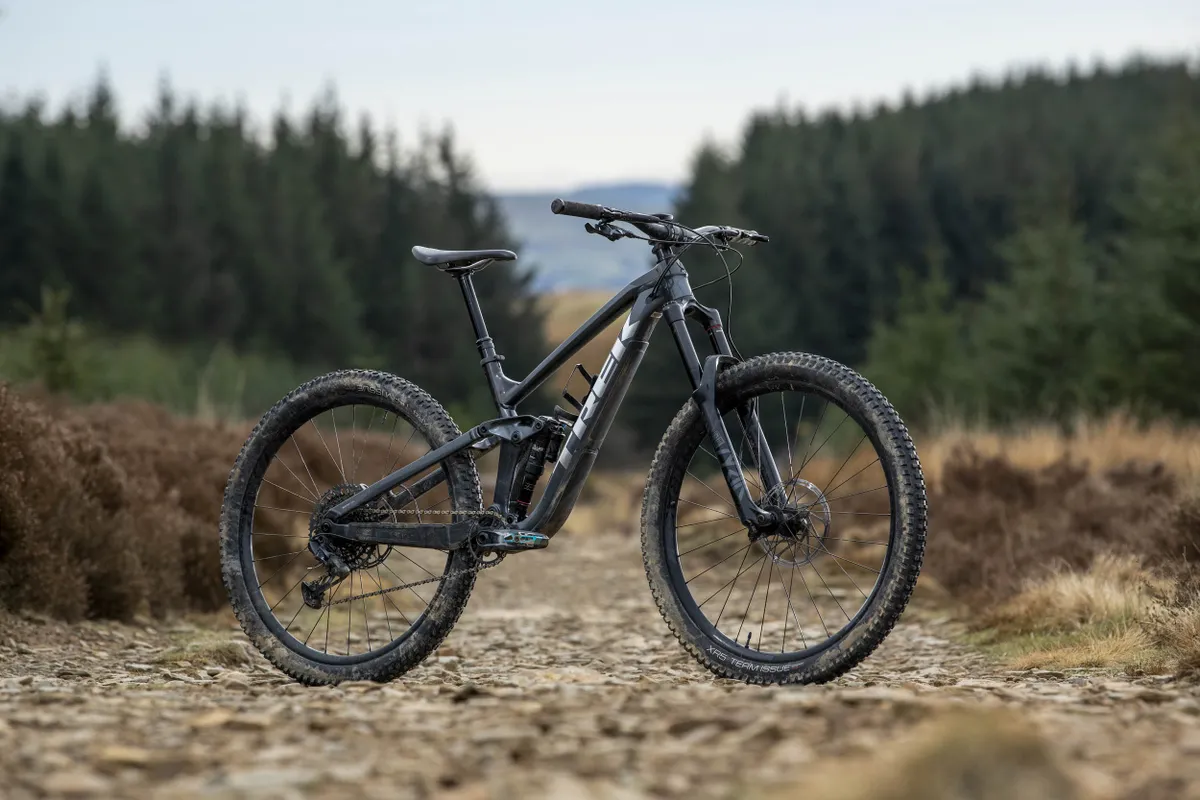
Travel has been upped to 160mm at the rear and is now paired with a longer travel 170mm travel fork up front. It continues to be delivered via Trek’s Active Braking Pivot (ABP) suspension system which places the chainstay pivot concentric to the rear axle.
This design, in Trek’s words, enables it to “tune how the suspension reacts to acceleration and braking forces independently”. And while this might look unchanged, Trek has moved the main pivot up slightly in a bid to increase anti-squat and make the Slash pedal more efficiently.
Controlling that 160mm of travel is the proprietary RockShox Super Deluxe Thru Shaft shock. This design features a shock shaft that goes through the damper body and exits out of the bottom of the shock when compressed.
This means that the shaft doesn’t displace any extra oil as it enters the damper and therefore does away with the need for a dynamic IFP (internal floating piston – which is what compensates for oil displaced by the shock shaft) – something that Trek attributes additional complexity and lag as the shock transitions between the compression and rebound phase, thanks to the reduction in friction.
The theory, at least, should make the back end of the Slash feel seamlessly smooth and incredibly active. It’s also worth noting that the Slash will work with a standard shock as well.
Where the Slash differs from almost all other aluminium frames (and the majority of carbon ones, too), is its internal frame storage. Slide the lever below the bottle cage downward, lift the cage and hatch door up and off the down tube and you’ll find a handy opening, much like the S.W.A.T storage found on some Specialized carbon frames.
You’ll be able to squirrel away a tube and tools in here, rather than carry them on your person. Trek includes a tool roll to help prevent things rattling once stashed inside, too.
While the down tube shape has changed slightly with the latest iteration of the Slash and now offers enough room for the fork crown to clear it, thanks to the subtle curve just behind the head tube junction, Trek has stuck with its steering limiting Knock Block system.
Knock Block stops the bar from turning past a certain angle, preventing the controls on the bar from potentially impacting the top tube and breaking, or, as with the old Slash, the fork crown hitting the down tube.
The latest Knock Block 2.0 used here offers a much greater steering angle before it stops the bar from turning (72 degrees rather than 58 degrees), but if that’s still not enough for you, it can be removed.

Finally, Trek has moved to a wider diameter seatpost, opting to go with the less-common 34.9mm rather than the more popular 30.9mm or 31.6mm alternatives.
While you’ll find fewer aftermarket alternatives should you wish to upgrade your dropper post, it’s worth noting the benefits that this broader diameter brings. The main one is more space internally for the dropper post mechanism, which should make the post more reliable and stiffer.
Trek Slash 8 geometry
The Slash has been, like most other enduro-style bikes in need of a makeover, stretched out, slackened and steepened in all the relevant areas. My medium frame offers a very reasonable 450mm reach, which is a massive jump of 25mm in the low setting over the 2020 model.
Trek has relaxed the head angle for improved high-speed stability and paired it with a 42mm offset fork in a bid to create the ultimate composure through rough turns. I measured the head angle at 64.1 degrees, which is now pretty much standard for bikes like this.
The seat angle has been steepened by a staggering 2 degrees in a bid to improve climbing efficiency, putting the rider’s hips more directly over the bottom bracket.
With my saddle set at just under 700mm (measured from the centre of the bottom bracket to the top of the saddle), the effective seat tube angle of the Slash 8 measured just over 76 degrees in the low setting.
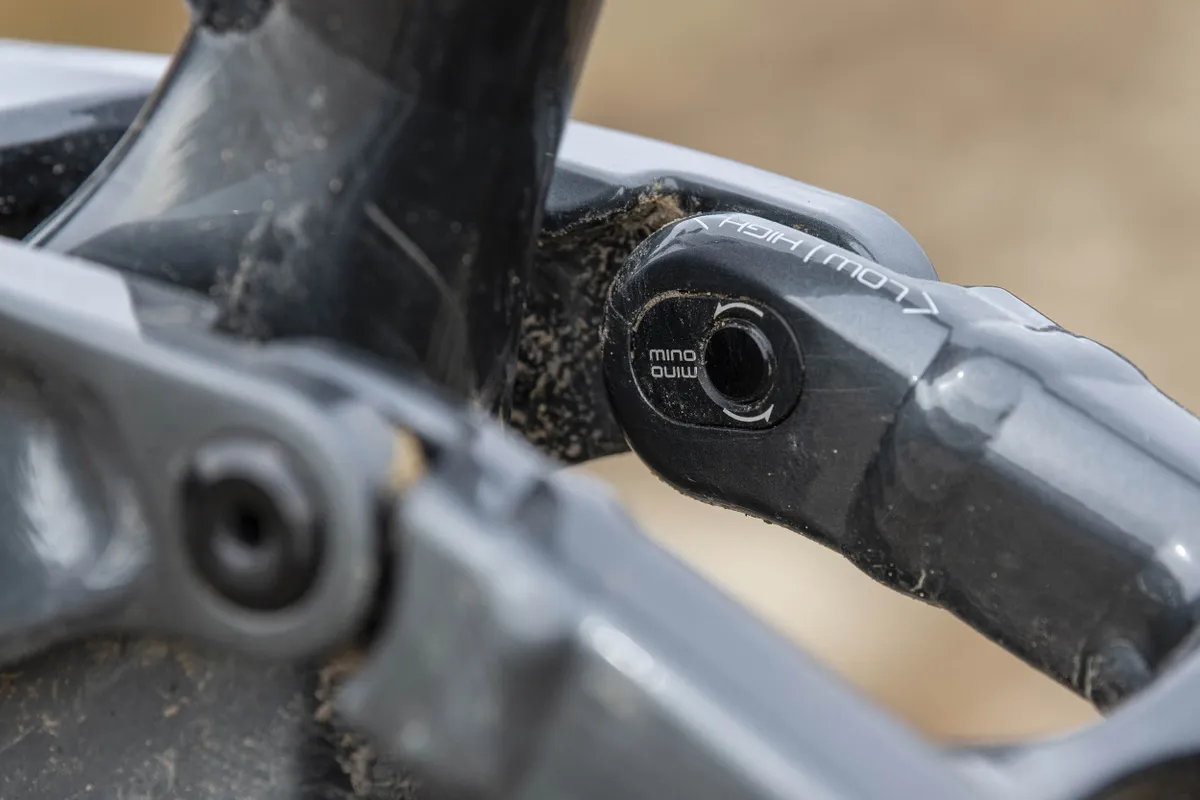
The two geometry settings (low and high) are accessed via the Mino Link ovalised chips that sit inside the EVO rocker link on the seatstay pivot. Switching between the two settings alters the head and seat angles by 0.5 degrees and the bottom bracket height by a substantial 8mm.
In the low setting, I measured the bottom bracket at 344mm off the floor with a drop of 29mm, which certainly isn’t bad for a bike with this much travel.
Effective chainstay length has increased by just 2mm (now up to 437mm) compared with the 2020 model, and this remains constant across all frame sizes.
Trek Slash 8 geometry (low setting)
| | S | M | ML | L | XL |
|---|---|---|---|---|---|
| Seat angle (degrees) | 75.6 | 75.6 | 75.6 | 75.6 | 75.6 |
| Head angle (degrees) | 64.1 | 64.1 | 64.1 | 64.1 | 64.1 |
| Chainstay (cm) | 43.7 | 43.7 | 43.7 | 43.7 | 43.7 |
| Seat tube (cm) | 39.5 | 42 | 43.5 | 45 | 50 |
| Top tube (cm) | 58.5 | 61 | 62.9 | 64.9 | 68.4 |
| Head tube (cm) | 10 | 10 | 10.5 | 11.5 | 14 |
| Fork offset (cm) | 4.3 | 4.3 | 4.3 | 4.3 | 4.3 |
| Trail (cm) | 13.4 | 13.4 | 13.4 | 13.4 | 13.4 |
| Bottom bracket drop (cm) | 2.9 | 2.9 | 2.9 | 2.9 | 2.9 |
| Bottom bracket height (cm) | 34.5 | 34.5 | 34.5 | 34.5 | 34.5 |
| Wheelbase (mm) | 1,197 | 1,222 | 1,243 | 1,264 | 1,305 |
| Standover (cm) | 706 | 744 | 744 | 754 | 774 |
| Stack (cm) | 62.1 | 62.2 | 62.6 | 63.5 | 65.8 |
| Reach (cm) | 42.5 | 45 | 46.9 | 48.6 | 51.6 |
Trek Slash 8 specifications
The Slash 8 is a serious looker with some great kit bolted to it. Ask anyone at the trail head how much they think it’s worth and chances are they’ll give you a price far higher than its true value.
Let’s start with the suspension. The proprietary RockShox Super Deluxe Ultimate Thru Shaft rear shock – which, by the way, is impressive to see on a bike at this price – is paired with a Lyrik Select+ fork that pumps out 170mm of travel.
While this might not be the top-tier, all singing, all dancing Lyrik, it still gets the Charger 2.1 RC damper, which allows you to finely tune both the low-speed compression and rebound damping.
A SRAM GX Eagle drivetrain offers a decently wide spread of gears, thanks to that 10-52t cassette.
Again, it’s impressive to see a drivetrain like this on a bike at this price. That said, Trek has saved a little cash by opting to use the cheaper X1 cranks with a stamped steel chainring, rather than the sleeker finished GX equivalents.

Stopping duties are taken care of by a powerful set of SRAM Code R brakes that clamp around 200mm (front)/180mm (rear) rotors. At the lever, there’s tool-free reach adjust which is handy for dialling in lever set up.
The rest of the kit on the Slash 8 comes courtesy of Trek’s in-house components brand Bontrager: bar, stem, grips, dropper post and the rather firm Arvada saddle.
Bontrager also takes care of the wheels, Line Comp 30s, as well as the tyres, speccing XR5 Team Issues upfront and the lower profile and narrower XR4 Team issue at the rear.
All in, my medium Slash 8 weighed 15.25kg.
Trek Slash 8 ride impressions
Set up on the Slash was relatively straight forward; I set the sag at the rear to 30 per cent and didn’t add any more pressure to the shock during testing.
I did find I needed to toggle the low-speed compression dial into the ‘+’ setting on the shock to get the support I was after through high-load turns and up take-offs.
Setting the rebound took a bit of playing around with, too, but in the end, I settled on four clicks from fully closed, which left it feeling fast and active but still controlled when returning from deep in the travel.
I stuck with the single volume spacer in the Lyrik fork and added 14 clicks of low-speed compression from fully closed with 70psi in the spring. This coupled with 12 clicks of rebound damping left the fork feeling active and supple yet still composed enough when the hits came thick and fast.
I tested the Slash 8 on a mix of steep, natural trails littered with roots and rocks, but all of them were generally quite slow due to their technical nature. So I spent a decent chunk of time getting some high-speed bikepark laps under my belt, subjecting the Slash 8 to fast, flowy trails, high-load turns, jumps and long stretches of jagged rocks, just to see how well it held up when the pace really picked up.
Big thanks to Bikepark Wales for letting us come and use the facilities to test despite being closed.
Trek Slash 8 climbing performance
The Slash felt incredibly easy-going when pointed uphill, especially considering the travel on tap and its outright intentions. This is mainly due to the easy-rolling tyres and just how stable the back end of the bike is when seated and spinning a gear.
At no point did I reach down for the shock's lever to firm things up because I never felt the need to. Instead, the Slash managed to sit relatively high in its travel and remain stable, with little in the way of suspension bob while the power was being applied.
Because the shock wasn’t sinking too deeply into its travel, the Slash managed to maintain its reasonably steep seat angle, which puts you in a nicely efficient, but most importantly, comfortable position for climbing. Even on steeper pitches where I was really mashing the pedals, I never once felt the need to firm the shock up.
While the 610mm effective top tube isn’t massive, it is longer (not by much) than a number of its contemporaries. While I wasn’t overly bothered by this on shorter climbs, I really started to appreciate the space this created when seated on much longer climbs up the hill.
I also appreciated the big 52t cog on the SRAM GX Eagle cassette which, after spending a long day riding lap after lap, I spent more than my fair share of time using to help preserve energy when I was really feeling fatigued but couldn’t face getting off and walking.
Trek Slash 8 descending performance
Thanks to the frame's well-considered proportions, the Slash offers up a well-centred, confident ride position, and it doesn’t take long to adapt to.
When pointed down steeper, more natural trails, I was instantly impressed by how well balanced the bike felt front to rear and how active the back end of the bike remained while it worked tirelessly trying to eke out every ounce of traction available.
And this was despite the lack of bite from the XR4 rear tyre, which doesn’t offer quite the same in terms of corner traction or braking grip compared to the likes of a Maxxis DHR II, for example.
The front tyre was a little better, but when properly leaned over in a soft, muddy turn, the shoulder tread doesn’t dig in quite as well as others, which can make for some dicey moments when the tyres do break traction.
Thankfully things remain quite predictable, so you know when you’ve reached their limit. Still, there’s no knocking their rapid rolling speed on smoother, harder packed terrain.
It was when riding a dedicated jump trail that I started playing around with the low-speed compression settings on the shock. In the default ‘zero’ setting, I was finding that I wasn’t getting as much support in the mid-stroke as I’d have liked when loading the bike from turn to turn or pumping up take-offs.
Switching the low-speed dial to the ‘+’ position helped to cure this and while Trek says this setting is designed for this exact type of riding, I never found any drawbacks when riding other types of terrain while in it.
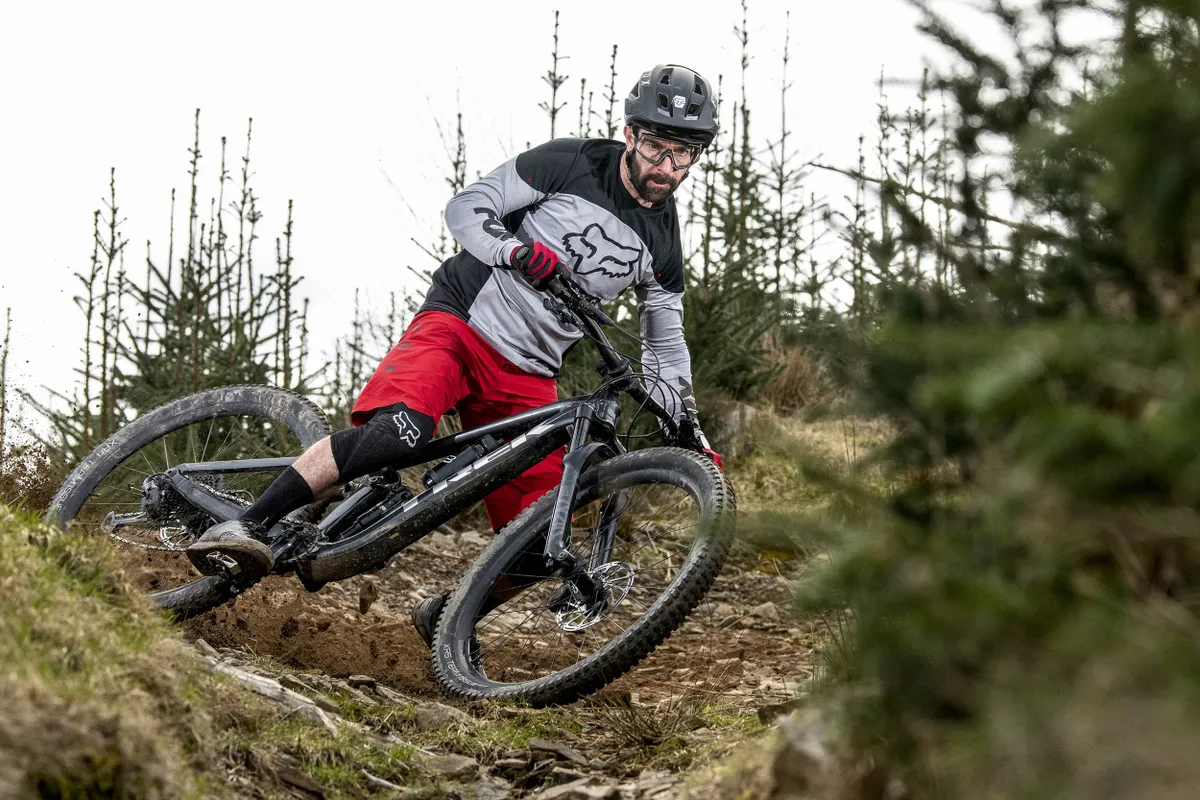
Throw the Slash 8 back into the technical stuff and its confident manner really starts to come to the fore as speeds pick up. Stove it head-on into a boulder field and the way this bike deals with the chaos is seriously impressive.
The Slash’s super-supple suspension recovers so rapidly hit after hit, it manages to track the trail with pin-point accuracy and without sinking too low into its travel or sacrificing any of that much-loved liveliness or pop.
The support through the suspension coupled with the taut feel through the frame ensures that you can really feel a difference in speed as you pump every bump or undulation.
That reactiveness also means that getting back up to speed after tackling a slower section or awkward obstacle doesn’t feel anywhere near as laboured as it can on some super-plush big travel rigs.
Slam on the impressively punchy Code R brakes, spot your line and commit, and the Slash will soak up whatever mess lies beneath the tyres and fire you out the other side faster than you thought possible.
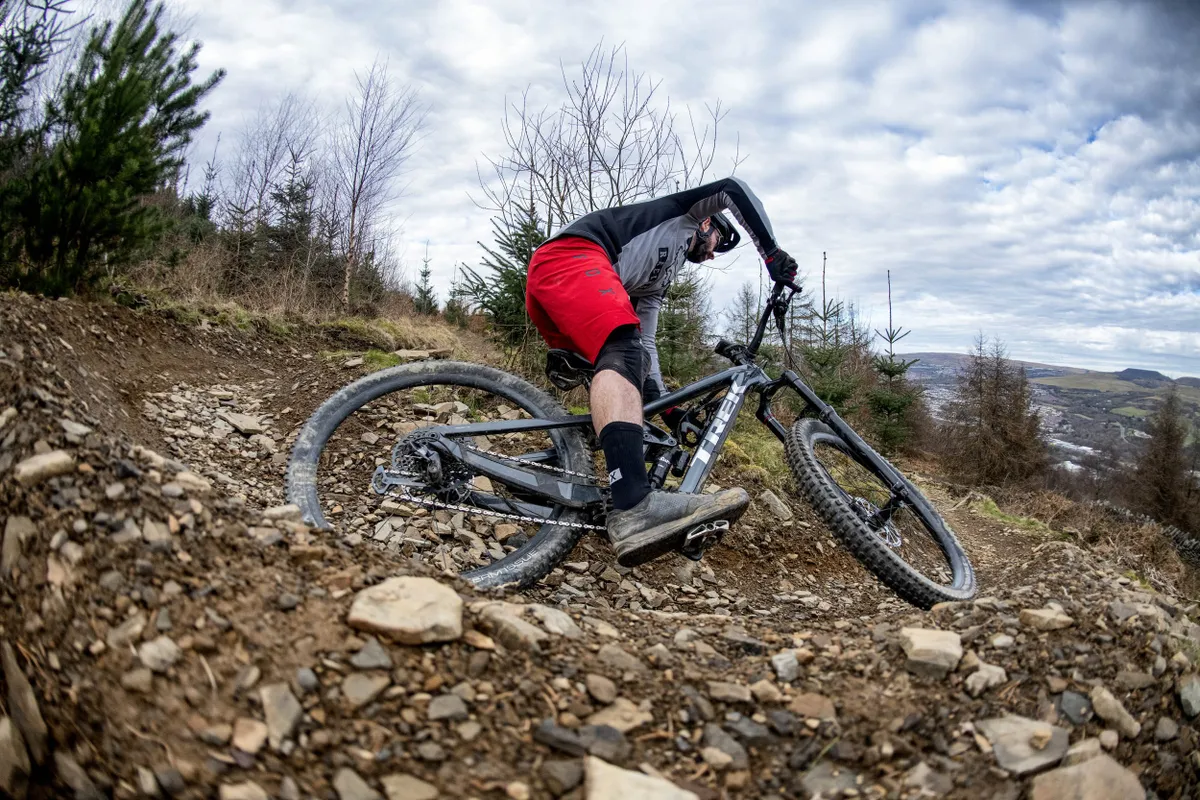
It’s easy to hold onto that speed too, even when things get really ugly. Here, the calm exuded by the Slash is simply incredible. While the wheels frantically bash through bump after bump beneath you, it feels as if the chassis barely flinches, isolating the rider from the worst of the feedback and remaining steadfast with no awkward pitching back or forth.
It’s this illusion of tranquillity that the Slash manages to conjure up to give you what feels like extra time to make these split-second decisions.
The Slash’s ability to hoover up the chunder with relative ease makes riding faster a whole lot easier. And that’s the whole point of these bikes, right?
Trek Slash 8 bottom line
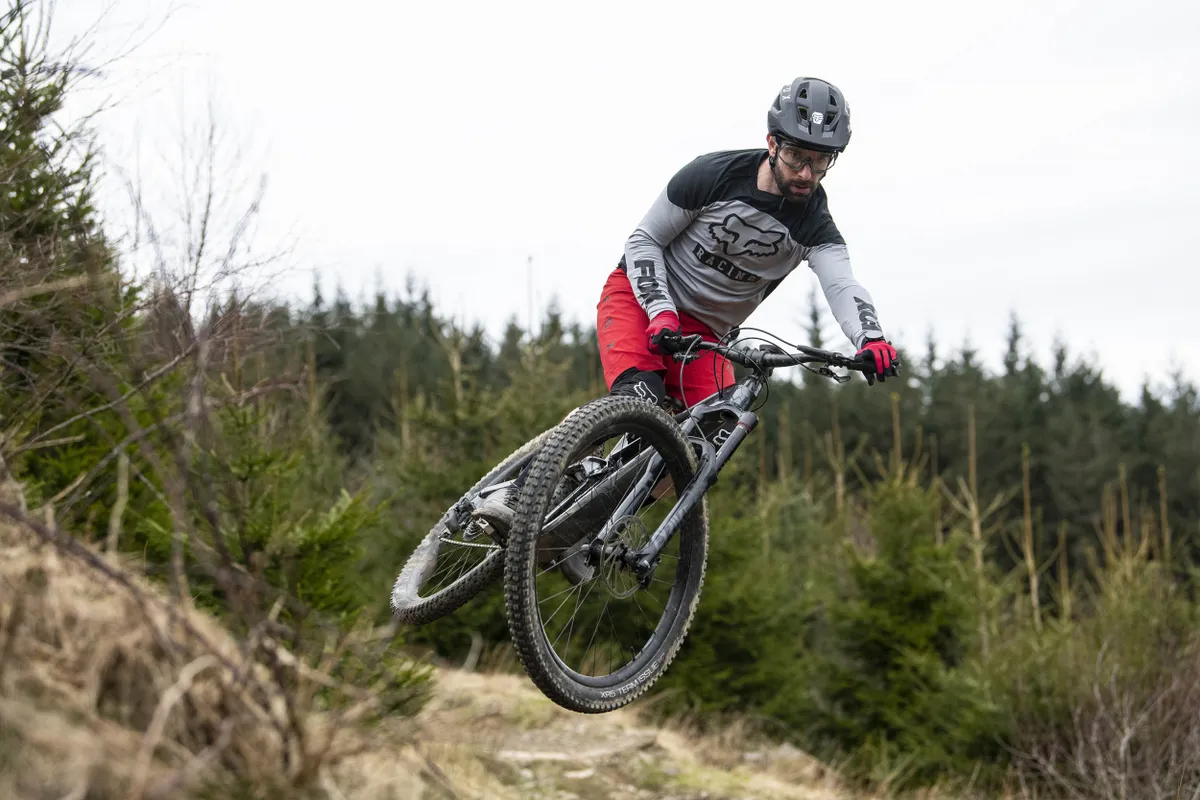
It took some back-to-back testing to really highlight just how impressive the Slash can be when tackling the rowdiest of terrain, but thanks to its impressive climbing manners, tidy frame details, good geometry and superb suspension, the new Trek Slash 8 has truly won me over.
While others like the Whyte G-180 might feel closer to a downhill bike in many ways, the Trek’s composure in the rough coupled with the fact that it still feels that bit more agile, poppy and playful is what helps to make this bike truly shine.
Yes, some better tyres would really help improve its performance when it comes to tackling steep, natural, muddy trails (and after switching tyres I can confirm this is the case) but factoring in the extra rubber cost at the point of purchase certainly isn’t a dealbreaker.
Overall, the Slash 8 impressed time and time again on a multitude of terrain and I was constantly in awe of the speed this thing carries through the nastiest of terrain.
Thanks to…
A massive thank-you to BikePark Wales for granting us access to its trails despite the bike park being closed to the public.
Cheers also to Fox clothing for sorting the kit for the photo and video shoots and Garmin for sorting us out with bike computers to log the many miles of testing.
And not forgetting Muc-Off, for its help keeping the bikes washed and lubed throughout testing.
Product
| Brand | trek |
| Price | 6300.00 AUD,3699.00 EUR,3450.00 GBP,4200.00 USD |
| Weight | 15.2500, KILOGRAM (M) - |
Features
| Fork | RockShox Lyrik Select+, 170mm travel |
| br_stem | Bontrager Line, 40mm |
| br_chain | SRAM GX Eagle |
| br_frame | Alpha Platinum aluminium, 160mm travel |
| Tyres | Bontrager XR5 Team Issue 29x2.6in (fr)/Bontrager XR4 Team Issue 29x2.4 (r) |
| br_brakes | SRAM Code R (200mm/180mm rotors) |
| br_cranks | SRAM X1 Eagle |
| br_saddle | Bontrager Arvada |
| br_wheels | Bontrager Line Comp 30 |
| br_headset | Knock Block 2.0 |
| br_shifter | SRAM GX Eagle |
| br_cassette | SRAM GX Eagle |
| br_seatpost | TranzX, 150mm |
| br_gripsTape | Bontrager XR Trail Pro |
| br_handlebar | Bontrager Line, 820mm |
| br_rearShock | RockShox Super Deluxe Thru Shaft |
| br_bottomBracket | SRAM DUB |
| br_availableSizes | S, M, ML, L, XL |
| br_rearDerailleur | SRAM GX Eagle |
